Bullet Hole Charateristics
There
are cases that occur all the time where an examination of the victim's
body can't determine which bullet hole is the entrance and which is
the exit. Pretty critical when witnesses are saying something
like, "The
police officer came up behind my cousin and shot him in the
back!" When the body offers no evidence of bullet entrance
and bullet exit, firearm examiners will be called upon to examine the
victim's clothing.
When a
bullet strikes an object, such as clothing, a bullet entrance hole is
created and in a lot of cases the bullet will pass through the object
and produce an exit hole on the backside.
Bullet entrance holes typically have very even margins. Almost
all non-contact bullet entrance holes will be smaller in diameter
than the bullet due to the elasticity of the fabric. Some
firmer materials and larger caliber bullets with large hollow point
cavities may cause bullet entrance holes to be closer to the actual
bullet's diameter but in most cases the diameter of the bullet
entrance hole will be of little help in determining the caliber of
the bullet.
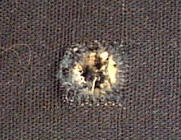
Typical bullet
entrance hole in a holster.
Contact or near contact
entrance holes and entrance holes caused by a bullet that has
struck an intermediate object will typically have very uneven
margins. Contact entrance holes will typically show
extreme damage to the material of a garment. Generally
speaking, the higher the velocity of the cartridge the greater
the damage to the garment in a contact gunshot.
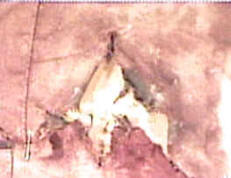
Typical contact entrance hole.
When a bullet strikes an
intermediate target (for example the victim's arm) before entering the
victim's shirt it may cause the bullet to fragment, expand, or even
tumble. The resulting secondary bullet entrance hole can be very
irregular in shape and hard to visibly distinguish from an exit
hole. Subsequent testing for gunshot residues usually help in
making this type of determination.
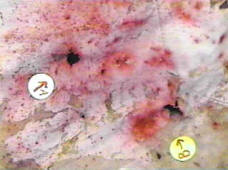
Two bullet 7.62X39mm entrance
holes where the bullets
struck a windshield prior to entering the garment.
Very irregular holes with fragmentation and lead spray (pink).
Bullets
that strike a target at an extreme angle will usually leave an elongated
hole. These holes typically
will still have fairly even margins.
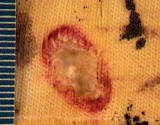
Angled bullet entrance
hole.
It's not too uncommon for a
grazing bullet to cause several holes in a wrinkled or folded garment.
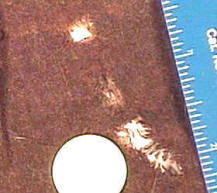
Angled grazing bullet holes made by a single bullet.
A common
characteristic of bullet entrance holes is the presence of bullet wipe
residue. Not always apparent on darker colored materials,
bullet wipe residue is a darkened ring around the immediate margins of the hole.
This ring of residue is caused by lead being wiped from
the surface of the bullet as it passes through the material. Lead
bullets normally leave the heaviest deposits of bullet wipe residue but
it is not unusual for jacketed bullets to also deposit bullet wipe
residue. Lead fouling in the barrel and lead primer residues
can be on the surface of a jacketed bullet.
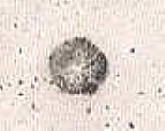
Bullet wipe residue around the margins
of a lead bullet entrance hole.
Chemically
processing a garment for lead residues will cause a pink reaction around
the hole.
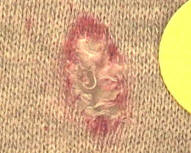
Bullet wipe residue after chemical processing.
Bullet exit holes
are really not much to talk about. Full-metal-jacketed or round nosed
bullets may leave holes that are similar to bullet entrance holes but most will
be absent of bullet wipe residue. If bullet wipe residue is present it
will normally be very light and on the inside of the exit hole. Bullet exit holes caused by
fragmented or expanded bullets usually have irregular margins and it's not too
uncommon for the bullet exit holes to be larger in diameter than the original
diameter of the bullet. Fragmented bullets will typically grab the
material of an object as it passes through causing the material to be frayed
outward.
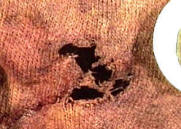
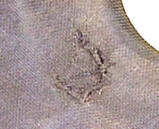
Typical Bullet Exit Holes
Once the bullet holes have been
examined and fully documented, it's time to start looking for evidence that may
allow for a distance determination to be made.
|